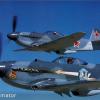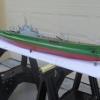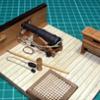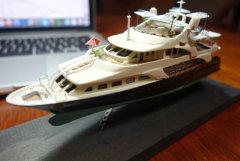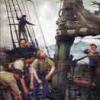MORE HANDBOOKS ARE ON THEIR WAY! We will let you know when they get here.
×
-
Posts
366 -
Joined
-
Last visited
Reputation Activity
-
 steamschooner got a reaction from aviaamator in Deck cleats How I made some.
steamschooner got a reaction from aviaamator in Deck cleats How I made some.
I needed some deck cleats for my current build. There are many ways of making cleats this is just the method I used.
I started by carving a master pattern and in this case out of wood. Once the size of the master was determined I could size the mold former. I use sections of copper pipe of various lengths and diameters. The basic setup is shown in the drawing. I start with a layer of vulcanizing rubber on the bottom. I than locate and install a couple of short pieces of copper wire to use as vents. Insert the master pattern and fill mold former the rest of the way up. Next set is to place filled mold former between a couple of metal plates with a C clamp for the oven baking time. Once it has been baked and cooled down I take a razor knife and cut a parting line in the mold to release the master pattern. The mold is placed back in the mold former and a small amount of casting metal is poured on top. I than press a flat wood or metal plate on top and press the metal into the mold. That is why you need vents so the trapped air has some place to go. Let the filled mold cool for a few, taking them out to quickly can damage the parts. I than like to lightly sand blast the parts to give them some texture and to dull them down some. Once that is done a coat of india ink is applied
and let dry for awhile than rubbed down to get any extra ink removed. I kept the base of the cleat thick on purpose so that I had a handle to hold them. I than used a saw to cut off the base to the thickness I wanted. As can be seen in last photo the master pattern does not allways come out in one piece.
-
 steamschooner got a reaction from dj.bobo in Making Fire buckets
steamschooner got a reaction from dj.bobo in Making Fire buckets
I needed to make a half dozen fire buckets for my project so I took a few photo's to show how I made mine. Once I had a size in mind I made a pattern and cut some thin brass to that shape. I than tinned opposite ends and opposite sides. So that when the brass is rolled into a cone the tinned ends will be face to face. I used a tapered dowel to help form the rolled cone shape for soldering. The rolled forms are a little long/tall for triming down later. Using a block of wood with a hole drilled just shy of bucket height and snug at the top i than placed a ring of wire around top of bucket and soldered in place. using the tapered dowel while soldering ring in to place helped line things up. Should come out looking like this. the next step was to cut out small disc of brass that was just a bit bigger than the bottom of bucket. with the disc on the end of the tapered dowel a bucket was lower over the end and pushed the disc to the bottom of bucket but not clear thur. Just enough of a lip to solder it in place, Some clean up with files and paper is next. Lastly some paint and install handle. Not sure when it became the practice of painting fire buckets red or if there ever was a rule to do so.
-
 steamschooner got a reaction from Canute in Deck cleats How I made some.
steamschooner got a reaction from Canute in Deck cleats How I made some.
I needed some deck cleats for my current build. There are many ways of making cleats this is just the method I used.
I started by carving a master pattern and in this case out of wood. Once the size of the master was determined I could size the mold former. I use sections of copper pipe of various lengths and diameters. The basic setup is shown in the drawing. I start with a layer of vulcanizing rubber on the bottom. I than locate and install a couple of short pieces of copper wire to use as vents. Insert the master pattern and fill mold former the rest of the way up. Next set is to place filled mold former between a couple of metal plates with a C clamp for the oven baking time. Once it has been baked and cooled down I take a razor knife and cut a parting line in the mold to release the master pattern. The mold is placed back in the mold former and a small amount of casting metal is poured on top. I than press a flat wood or metal plate on top and press the metal into the mold. That is why you need vents so the trapped air has some place to go. Let the filled mold cool for a few, taking them out to quickly can damage the parts. I than like to lightly sand blast the parts to give them some texture and to dull them down some. Once that is done a coat of india ink is applied
and let dry for awhile than rubbed down to get any extra ink removed. I kept the base of the cleat thick on purpose so that I had a handle to hold them. I than used a saw to cut off the base to the thickness I wanted. As can be seen in last photo the master pattern does not allways come out in one piece.
-
 steamschooner reacted to Mirabell61 in SS Kaiser Wilhelm der Grosse 1897 by Mirabell61 - FINISHED - scale 1:144 - POF - first German four stacker of the Norddeutscher Lloyd line
steamschooner reacted to Mirabell61 in SS Kaiser Wilhelm der Grosse 1897 by Mirabell61 - FINISHED - scale 1:144 - POF - first German four stacker of the Norddeutscher Lloyd line
Hi Piet,
yes sorry, I should have explained a bit better.......
The pic now should be self explaining. The sample bag foot button in the middle still has the fastening device..
Nils
-
 steamschooner reacted to schooner in SS Stephen Hopkins by schooner - FINISHED - BlueJacket Shipcrafters - Liberty Ship
steamschooner reacted to schooner in SS Stephen Hopkins by schooner - FINISHED - BlueJacket Shipcrafters - Liberty Ship
Mast Houses
The mast houses are made up of 2 stacked laser cut pieces with the holes for the masts and ventilators pre-drilled.
Given the rough faces from the laser cutting and the need to eliminate the seam between the pieces I thought that sanding them smooth would be tedious and might result in rounded corners so I decided to face them with sheet styrene. Doing so gave a nice smooth “steel” finish, sharp corners and a slight coaming along the deck edge.
The details are a combination of kit items, scratch, and after market. Between them they are the anchor point for 15 masts, booms and cranes so there will be a lot of rigging around them.
Next will be the start of adding the 160+ bulwark braces (maybe not tedious but certainly repetitive).
-
 steamschooner got a reaction from Piet in SHADOW by Omega1234 - FINISHED - Scale 1/300 - Luxury 60m Mega Yacht
steamschooner got a reaction from Piet in SHADOW by Omega1234 - FINISHED - Scale 1/300 - Luxury 60m Mega Yacht
So another mind boggling miniature, I'll hang around and watch with the rest of them.
-
 steamschooner got a reaction from wefalck in Deck cleats How I made some.
steamschooner got a reaction from wefalck in Deck cleats How I made some.
I needed some deck cleats for my current build. There are many ways of making cleats this is just the method I used.
I started by carving a master pattern and in this case out of wood. Once the size of the master was determined I could size the mold former. I use sections of copper pipe of various lengths and diameters. The basic setup is shown in the drawing. I start with a layer of vulcanizing rubber on the bottom. I than locate and install a couple of short pieces of copper wire to use as vents. Insert the master pattern and fill mold former the rest of the way up. Next set is to place filled mold former between a couple of metal plates with a C clamp for the oven baking time. Once it has been baked and cooled down I take a razor knife and cut a parting line in the mold to release the master pattern. The mold is placed back in the mold former and a small amount of casting metal is poured on top. I than press a flat wood or metal plate on top and press the metal into the mold. That is why you need vents so the trapped air has some place to go. Let the filled mold cool for a few, taking them out to quickly can damage the parts. I than like to lightly sand blast the parts to give them some texture and to dull them down some. Once that is done a coat of india ink is applied
and let dry for awhile than rubbed down to get any extra ink removed. I kept the base of the cleat thick on purpose so that I had a handle to hold them. I than used a saw to cut off the base to the thickness I wanted. As can be seen in last photo the master pattern does not allways come out in one piece.
-
 steamschooner got a reaction from Elijah in SHADOW by Omega1234 - FINISHED - Scale 1/300 - Luxury 60m Mega Yacht
steamschooner got a reaction from Elijah in SHADOW by Omega1234 - FINISHED - Scale 1/300 - Luxury 60m Mega Yacht
So another mind boggling miniature, I'll hang around and watch with the rest of them.
-
 steamschooner got a reaction from BANYAN in Deck cleats How I made some.
steamschooner got a reaction from BANYAN in Deck cleats How I made some.
I needed some deck cleats for my current build. There are many ways of making cleats this is just the method I used.
I started by carving a master pattern and in this case out of wood. Once the size of the master was determined I could size the mold former. I use sections of copper pipe of various lengths and diameters. The basic setup is shown in the drawing. I start with a layer of vulcanizing rubber on the bottom. I than locate and install a couple of short pieces of copper wire to use as vents. Insert the master pattern and fill mold former the rest of the way up. Next set is to place filled mold former between a couple of metal plates with a C clamp for the oven baking time. Once it has been baked and cooled down I take a razor knife and cut a parting line in the mold to release the master pattern. The mold is placed back in the mold former and a small amount of casting metal is poured on top. I than press a flat wood or metal plate on top and press the metal into the mold. That is why you need vents so the trapped air has some place to go. Let the filled mold cool for a few, taking them out to quickly can damage the parts. I than like to lightly sand blast the parts to give them some texture and to dull them down some. Once that is done a coat of india ink is applied
and let dry for awhile than rubbed down to get any extra ink removed. I kept the base of the cleat thick on purpose so that I had a handle to hold them. I than used a saw to cut off the base to the thickness I wanted. As can be seen in last photo the master pattern does not allways come out in one piece.
-
 steamschooner got a reaction from Tadeusz43 in Deck cleats How I made some.
steamschooner got a reaction from Tadeusz43 in Deck cleats How I made some.
I needed some deck cleats for my current build. There are many ways of making cleats this is just the method I used.
I started by carving a master pattern and in this case out of wood. Once the size of the master was determined I could size the mold former. I use sections of copper pipe of various lengths and diameters. The basic setup is shown in the drawing. I start with a layer of vulcanizing rubber on the bottom. I than locate and install a couple of short pieces of copper wire to use as vents. Insert the master pattern and fill mold former the rest of the way up. Next set is to place filled mold former between a couple of metal plates with a C clamp for the oven baking time. Once it has been baked and cooled down I take a razor knife and cut a parting line in the mold to release the master pattern. The mold is placed back in the mold former and a small amount of casting metal is poured on top. I than press a flat wood or metal plate on top and press the metal into the mold. That is why you need vents so the trapped air has some place to go. Let the filled mold cool for a few, taking them out to quickly can damage the parts. I than like to lightly sand blast the parts to give them some texture and to dull them down some. Once that is done a coat of india ink is applied
and let dry for awhile than rubbed down to get any extra ink removed. I kept the base of the cleat thick on purpose so that I had a handle to hold them. I than used a saw to cut off the base to the thickness I wanted. As can be seen in last photo the master pattern does not allways come out in one piece.
-
 steamschooner got a reaction from mtaylor in SHADOW by Omega1234 - FINISHED - Scale 1/300 - Luxury 60m Mega Yacht
steamschooner got a reaction from mtaylor in SHADOW by Omega1234 - FINISHED - Scale 1/300 - Luxury 60m Mega Yacht
So another mind boggling miniature, I'll hang around and watch with the rest of them.
-
 steamschooner got a reaction from mischief in Deck cleats How I made some.
steamschooner got a reaction from mischief in Deck cleats How I made some.
I needed some deck cleats for my current build. There are many ways of making cleats this is just the method I used.
I started by carving a master pattern and in this case out of wood. Once the size of the master was determined I could size the mold former. I use sections of copper pipe of various lengths and diameters. The basic setup is shown in the drawing. I start with a layer of vulcanizing rubber on the bottom. I than locate and install a couple of short pieces of copper wire to use as vents. Insert the master pattern and fill mold former the rest of the way up. Next set is to place filled mold former between a couple of metal plates with a C clamp for the oven baking time. Once it has been baked and cooled down I take a razor knife and cut a parting line in the mold to release the master pattern. The mold is placed back in the mold former and a small amount of casting metal is poured on top. I than press a flat wood or metal plate on top and press the metal into the mold. That is why you need vents so the trapped air has some place to go. Let the filled mold cool for a few, taking them out to quickly can damage the parts. I than like to lightly sand blast the parts to give them some texture and to dull them down some. Once that is done a coat of india ink is applied
and let dry for awhile than rubbed down to get any extra ink removed. I kept the base of the cleat thick on purpose so that I had a handle to hold them. I than used a saw to cut off the base to the thickness I wanted. As can be seen in last photo the master pattern does not allways come out in one piece.
-
 steamschooner got a reaction from Mirabell61 in Deck cleats How I made some.
steamschooner got a reaction from Mirabell61 in Deck cleats How I made some.
I needed some deck cleats for my current build. There are many ways of making cleats this is just the method I used.
I started by carving a master pattern and in this case out of wood. Once the size of the master was determined I could size the mold former. I use sections of copper pipe of various lengths and diameters. The basic setup is shown in the drawing. I start with a layer of vulcanizing rubber on the bottom. I than locate and install a couple of short pieces of copper wire to use as vents. Insert the master pattern and fill mold former the rest of the way up. Next set is to place filled mold former between a couple of metal plates with a C clamp for the oven baking time. Once it has been baked and cooled down I take a razor knife and cut a parting line in the mold to release the master pattern. The mold is placed back in the mold former and a small amount of casting metal is poured on top. I than press a flat wood or metal plate on top and press the metal into the mold. That is why you need vents so the trapped air has some place to go. Let the filled mold cool for a few, taking them out to quickly can damage the parts. I than like to lightly sand blast the parts to give them some texture and to dull them down some. Once that is done a coat of india ink is applied
and let dry for awhile than rubbed down to get any extra ink removed. I kept the base of the cleat thick on purpose so that I had a handle to hold them. I than used a saw to cut off the base to the thickness I wanted. As can be seen in last photo the master pattern does not allways come out in one piece.
-
 steamschooner got a reaction from Omega1234 in SHADOW by Omega1234 - FINISHED - Scale 1/300 - Luxury 60m Mega Yacht
steamschooner got a reaction from Omega1234 in SHADOW by Omega1234 - FINISHED - Scale 1/300 - Luxury 60m Mega Yacht
So another mind boggling miniature, I'll hang around and watch with the rest of them.
-
 steamschooner got a reaction from -Dallen in Making Fire buckets
steamschooner got a reaction from -Dallen in Making Fire buckets
I needed to make a half dozen fire buckets for my project so I took a few photo's to show how I made mine. Once I had a size in mind I made a pattern and cut some thin brass to that shape. I than tinned opposite ends and opposite sides. So that when the brass is rolled into a cone the tinned ends will be face to face. I used a tapered dowel to help form the rolled cone shape for soldering. The rolled forms are a little long/tall for triming down later. Using a block of wood with a hole drilled just shy of bucket height and snug at the top i than placed a ring of wire around top of bucket and soldered in place. using the tapered dowel while soldering ring in to place helped line things up. Should come out looking like this. the next step was to cut out small disc of brass that was just a bit bigger than the bottom of bucket. with the disc on the end of the tapered dowel a bucket was lower over the end and pushed the disc to the bottom of bucket but not clear thur. Just enough of a lip to solder it in place, Some clean up with files and paper is next. Lastly some paint and install handle. Not sure when it became the practice of painting fire buckets red or if there ever was a rule to do so.
-
 steamschooner reacted to captainbob in USCG Pequot (WARC-58) by captainbob - FINISHED - 1:96
steamschooner reacted to captainbob in USCG Pequot (WARC-58) by captainbob - FINISHED - 1:96
There’s a ladder that goes from the pilot house down to the main deck. I know that there are companies that make photo etched ladders but I don’t know which ones make good parts or how to order the one that I want. Then I would have to wait for it and hope it is the right size when it gets here. I’m just not up to that kind of stress. So I made my own. The photo I am following shows the ladder with ten treads. Measuring the model makes the treads .090 inch. So I sanded a 3/32 square strip down to .085 inch on one side. To make the fixture I used a .005” brass sheet as a spacer and glued the square strips between two supports. The treads were cut from the .005” sheet and squeezed into the fixture. The sides are 1/16” brass angle. Sorry I didn’t get a picture of the ladder mounted in the fixture. But here is a picture of the fixture and the a couple of the finished ladder.
Bob
-
 steamschooner reacted to Jim Lad in Francis Pritt by Jim Lad - FINISHED - Scale 1:48 - Australian Mission Ship
steamschooner reacted to Jim Lad in Francis Pritt by Jim Lad - FINISHED - Scale 1:48 - Australian Mission Ship
Now that the boats for the 'Herzogin Cecilie' are finished, I can finally get back to work on the 'Pritt'. I've finished the iron work for the masts and the masts are now fitted. When fitting masts I use a tiny dab of glue on the mast coat that touched only the mast and the deck, so that removing the masts (if ever required) is just a matter of cutting away the mast coat, while in the meantime the masts are held securely.
I had held back on fitting the masts as I hadn't been able to figure out from the photos the form of the spreaders that support the topmast shrouds, but a close ponder over a very highly magnified enlargement of the foremast had revealed that the spreaders are iron rods with holes in the end that are fixed to an additional mast band, so these have now been fitted. By the way, I'm not quite sure why the 'Pritt' had these upper shrouds. They're attached right at the top of the mast, but that's not really very far above the main shrouds and the 'Pritt' is the only pearler I've ever seen that has them fitted. She's also the only pearler I've ever seen with the running stays on both masts, as well, so perhaps she was sailed very hard at some time in her life and needed the extra support for the masts.
The photos below show the model with the masts fitted and some of the standing rigging over the mast heads. The third photo is a close up of the mainmast with the spaghetti of partially installed rigging and the spreaders.
John
-
 steamschooner reacted to Mirabell61 in SS Kaiser Wilhelm der Grosse 1897 by Mirabell61 - FINISHED - scale 1:144 - POF - first German four stacker of the Norddeutscher Lloyd line
steamschooner reacted to Mirabell61 in SS Kaiser Wilhelm der Grosse 1897 by Mirabell61 - FINISHED - scale 1:144 - POF - first German four stacker of the Norddeutscher Lloyd line
Little update....
Am just starting with fitting the aft part of the (raw and dryfit) boats deck into the metal framework. The lower portion of the aft mast also is fitted in place. The deck is of 0,8 mm thick 3-layer ply, and will be planked with 0,8 x 2mm pine planks with "pencil edge caulking", same as the promenade deck
Nils
-
 steamschooner got a reaction from Richard Griffith in Making Fire buckets
steamschooner got a reaction from Richard Griffith in Making Fire buckets
I needed to make a half dozen fire buckets for my project so I took a few photo's to show how I made mine. Once I had a size in mind I made a pattern and cut some thin brass to that shape. I than tinned opposite ends and opposite sides. So that when the brass is rolled into a cone the tinned ends will be face to face. I used a tapered dowel to help form the rolled cone shape for soldering. The rolled forms are a little long/tall for triming down later. Using a block of wood with a hole drilled just shy of bucket height and snug at the top i than placed a ring of wire around top of bucket and soldered in place. using the tapered dowel while soldering ring in to place helped line things up. Should come out looking like this. the next step was to cut out small disc of brass that was just a bit bigger than the bottom of bucket. with the disc on the end of the tapered dowel a bucket was lower over the end and pushed the disc to the bottom of bucket but not clear thur. Just enough of a lip to solder it in place, Some clean up with files and paper is next. Lastly some paint and install handle. Not sure when it became the practice of painting fire buckets red or if there ever was a rule to do so.
-
 steamschooner got a reaction from mtaylor in John Cudahy by steamschooner - FINISHED - 1/4" scale - Steam Tug
steamschooner got a reaction from mtaylor in John Cudahy by steamschooner - FINISHED - 1/4" scale - Steam Tug
Patrick, check out my post under Making Fire Buckets in the metal working, soldering section. I give a run down on how I made them.
-
 steamschooner got a reaction from tarbrush in John Cudahy by steamschooner - FINISHED - 1/4" scale - Steam Tug
steamschooner got a reaction from tarbrush in John Cudahy by steamschooner - FINISHED - 1/4" scale - Steam Tug
Just got done making some fire buckets for my project now I need a rack to put them in.
-

-

-

-
 steamschooner got a reaction from riverboat in Making Fire buckets
steamschooner got a reaction from riverboat in Making Fire buckets
I needed to make a half dozen fire buckets for my project so I took a few photo's to show how I made mine. Once I had a size in mind I made a pattern and cut some thin brass to that shape. I than tinned opposite ends and opposite sides. So that when the brass is rolled into a cone the tinned ends will be face to face. I used a tapered dowel to help form the rolled cone shape for soldering. The rolled forms are a little long/tall for triming down later. Using a block of wood with a hole drilled just shy of bucket height and snug at the top i than placed a ring of wire around top of bucket and soldered in place. using the tapered dowel while soldering ring in to place helped line things up. Should come out looking like this. the next step was to cut out small disc of brass that was just a bit bigger than the bottom of bucket. with the disc on the end of the tapered dowel a bucket was lower over the end and pushed the disc to the bottom of bucket but not clear thur. Just enough of a lip to solder it in place, Some clean up with files and paper is next. Lastly some paint and install handle. Not sure when it became the practice of painting fire buckets red or if there ever was a rule to do so.



